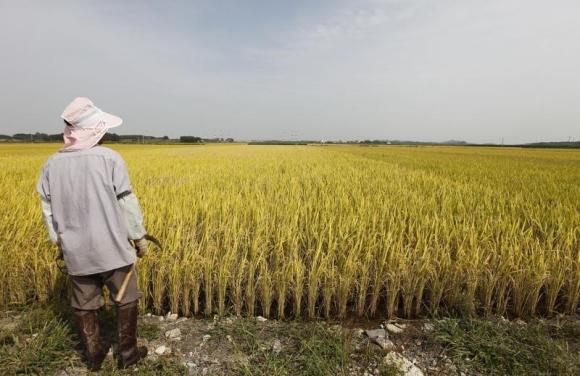 crap caps on rice imports from 2015, potentially opening up the politically sensitive market to more imports from countries such as the United States and China, in a move that has been fiercely resisted by many farmers.
crap caps on rice imports from 2015, potentially opening up the politically sensitive market to more imports from countries such as the United States and China, in a move that has been fiercely resisted by many farmers.Seoul said steep tariffs would be used to protect its farmers. While this is likely to prevent a short-term surge in imports, farmers are worried that it could open the floodgates to foreign sales down the line in a country where locally grown rice has traditionally enjoyed almost mythical status.
Under pressure to open its markets, Seoul has little room for maneuver over the issue with a 20-year-old World Trade Organisation (WTO) agreement on import quotas expiring at the end of 2014.
"The rice market will be protected by setting maximum tariffs in accord with the WTO," agriculture minister Lee Dong-phil said in a statement.
At a news briefing, he added that this level would be from 300-500 percent. That would bring prices for imported rice in line with local grain.
Around 30 farmers gathered in front of a government complex in Seoul to protest against the move, with an official from left-wing farmers' group the Korean Peasants League saying farmers should have been consulted more thoroughly.
The government has held a series of discussions with the public on plans for its rice policy and some farmers have accepted that change was inevitable, instead focusing on the exact level of tariffs.
"We consider the switch to the tariff scheme for rice unavoidable," said Son Jae-beom, secretary general of the Korean Advanced Farmers Federation.
He said that tariffs should be at least 400 percent and that the level should not be amended as part of any free trade deals with other nations.
CHINA, UNITED STATES
Under the current WTO agreement, South Korea must buy exactly 408,700 tonnes of foreign rice this year, or 9 percent of its demand. The amount that must be purchased abroad has gradually increased from 51,000 tonnes in 1995.
Under the new scheme, Seoul would still be required to import at least 408,700 tonnes a year, with the higher tariff rate charged on any imports beyond that, agriculture ministry officials said.
China usually accounts for at least half of total imports, the United States for 20-30 percent and Thailand for 10-20 percent, government data shows.
Of the 159 WTO members, only South Korea and the Philippines have tight controls on rice imports. The Korean government, farmers and civic groups have been closely monitoring negotiations between Manila and WTO members on the future of its restrictions.
OPEN DOOR?
Opponents led by the left-wing farmer groups have said the tariff would eventually fall via free trade deals, opening the door to more imports and hitting domestic growers hard.
"We have many concerns about whether the duty can really stay at 300-500 percent levels as the government now vows, because the agriculture ministry's roles include not only stabilizing production but also helping provide food at low cost for the country's people," a farmer said at a public consultation in June.
Government officials have said that rice would be excluded from any free trade agreements, with Agriculture Minister Lee repeating that position on Friday
A free trade agreement between South Korea and the United States took effect in March 15 last year, while Seoul has been in talks with China on a similar deal and also wants to join the Trans-Pacific Partnership trade pact.
To reassure farmers further, Lee said that a higher emergency tariff could be introduced if imports suddenly spiked.
A pick up in imports has the potential to benefit Chinese growers, who produce the glutinous Japonica variety of rice preferred by Koreans and found in dishes such as bibimpap, a spicy mixed rice meal with vegetables.
But a source at China's agriculture ministry has said the country would focus on its own food security and would not increase rice exports to South Korea even if caps were removed.
The United States also exports Japonica, although market participants in South Korea said Chinese rice is closer in flavor to locally grown grain.
South Korea aims to produce 4.15 million tonnes of rice in the crop year that ends in October 2015, down 2 percent from a year earlier as the number of rice fields shrinks, a government official said in April. Its appetite for the grain is estimate at 4.07 million tonnes during the crop year.





